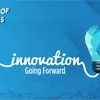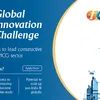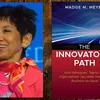Discovery, delivery, delight — how EY harnessed knowledge management and became one of two Most Outstanding Winners of the MIKE award
The annual knowledge summit of the Confederation of Indian Industry (CII) featured winners of the 2019 Most Innovative Knowledge Enterprise (MIKE) award. The EY organisation, one of two Most Outstanding Winners, shares insights from its knowledge journey in this interview.
CII’s annual knowledge summit was held entirely online this year, and was titled CII Global Knowledge Virtual Summit 2020: Knowledge in the Age of Artificial Intelligence. It was also supported by the Knowledge Management Global Network (KMGN).
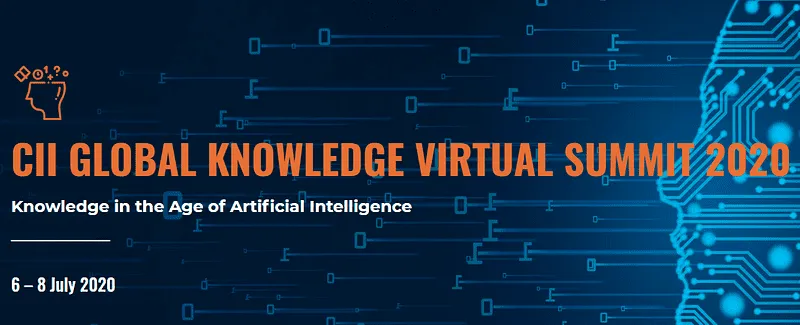
YourStory was the media partner for the flagship summits in 2019 and 2020. See our 15-part article series, which includes Knowledge Leadership, KM in the Age of AI, Gamification, Storytelling, Knowledge Sharing in the COVID-19 Era, and Eye on AI.
also moderated the panel on Knowledge Excellence: Winners of the Global MIKE Awards. (See my book series The KM Chronicles for case studies of earlier winners of the MAKE Awards and Singapore KM Excellence Awards.)
Vineet Jain is the Knowledge Leader for EY Global Delivery Services India Private Limited. He leads the knowledge function for EY Global Delivery Services organisation. Knowledge teams are located in centers based in Argentina, India, and Poland. The organisation includes research and analysis, knowledge management (KM), community and social enterprise, process modeling, and benchmarking function.
Vineet has more than 27 years of experience in consulting, investment banking, knowledge process outsourcing operations, business and financial research, and strategy. Previous employers include investment banks and other big four.
Vineet joins YourStory for an in-depth conversation about the EY knowledge journey, its next steps and leading practices.
See also our earlier profiles of MIKE award winners Tata Steel, Cognizant Technology Solutions, Afcons Infrastructure, Petroleum Development Oman, BINUS University, and Mobarakeh Steel Company.
YourStory [YS]: What are some impacts you can share of how knowledge management (KM) has benefited your company?
Vineet Jain [VJ]: EY is an organisation built on knowledge. We equip our 280,000+ professionals with the insights, tools, and connections they need to be successful in the market, deliver exceptional client value and build their careers. As a global organisation of member firms, we compete in a market where knowledge is the product; our insights, research and thought leadership differentiate us from the competition.
A key element in successful KM is the reuse of knowledge. At EY, we use Discover, a proprietary platform for knowledge sharing. Discover, a mobile-enabled suite of digital knowledge tools, offers an integrated experience for EY people, helping them easily and quickly find the content, intranet sites and people profiles they need.
Service delivery methodologies list Discover usage as a first step in any process. Based on a recent Knowledge Culture survey, 94 percent of EY teams are familiar with the key internal tools and content available, and the expectations for how they should use those tools in their daily work. The EY FY20 Global Knowledge Survey revealed that 93 percent of practitioners save time using knowledge content, tools and resources.
People across EY use Discover extensively. On an average, we have more than 500,000 monthly content views and more than 300,000 monthly page views across the platform.
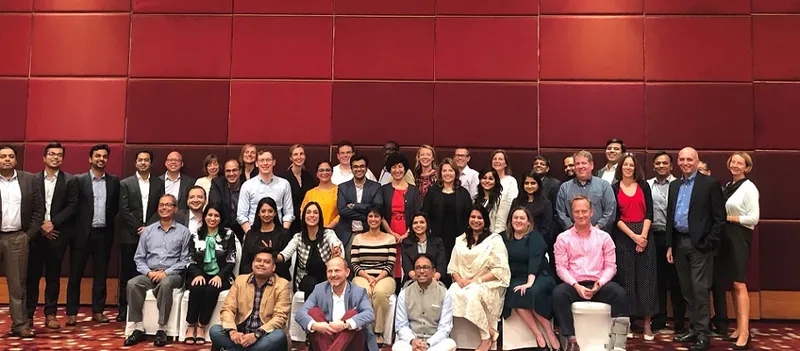
EY Knowledge’s leadership team during a workshop in India held during FY19
YS: Can you give some examples of processes where knowledge is embedded in the workflow, and other processes that require extra activity to manage or create knowledge?
VJ: At EY, we use the Discover Submission Bot, which transformed how we collect and share knowledge. By automating outreach to client engagement teams, the bot prompts teams to submit pursuit and service delivery knowledge artifacts. As a result, EY digital knowledge harvesting has reduced human intervention. By prompting engagement teams to submit and improve the knowledge sharing culture, EY professionals have access to the best content EY has to offer.
To help ensure intellectual property guidelines and client confidentiality for Discover submissions, we use the “Sanitisation Bot” to automate the sanitisation process for all documents attached to a request.
Alongside the bot detailed above, we use the innovative Workflow Allocation Bot to process and assign content requests. Using robotic process automation (RPA), the bot automatically estimates the effort necessary to process content management requests and then makes assignments, based on the complexity of work and the team’s availability.
These automations and optimisations have been recognised by the industry. One of our Knowledge leaders was recently recognised by Analytics Insights as one of 40 Innovators Under 40, for leading the automation and optimisation of EY knowledge management processes.
YS: What are some communities of practice (CoPs) you have that involve knowledge inputs from external members? Are you also using crowdsourcing in this regard?
VJ: EY facilitates external connections with customers, potential customers and talent, subject matter professionals, corporations and regulators in a number of ways, as described below.
· GigNow, an advanced technology platform that taps into the gig economy. It is part of a series of new global programs to prepare the workforce and business for the future of work.
· EYQ, the EY think tank, generates new insights by bringing together business, public sector and academic leaders to challenge entrenched thinking, shift perceptions and catalyse change.
· Public challenges, like the EY NextWave Data Science Program and EY Hackathons. These events connect data science and analytics university students and diverse talent communities across the globe, to use their skills to solve the big issues faced by businesses today, using blockchain, internet of things (IoT) and artificial intelligence (AI).
· Collaborations and acquisitions help us solve challenging problems by bringing in skills and resources in emerging areas. Having an ecosystem of specialised organisations, particularly technology providers, means we can offer a broader range of services and create value.
· CogniStreamer is a next-generation innovation management platform that helps EY people structure and solve innovation challenges. It has consistently been recognised by Forrester and Gartner as a leading innovation management platform.
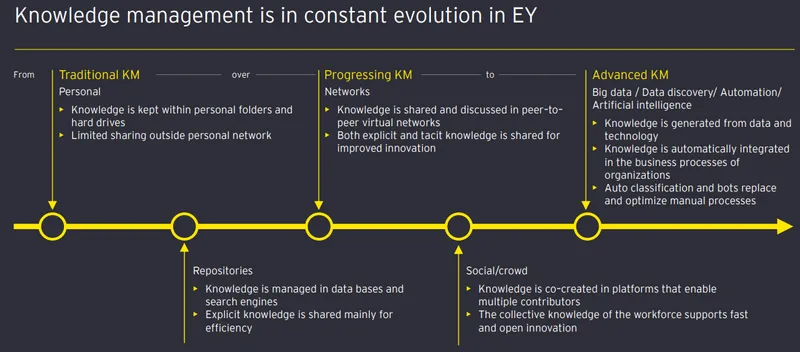
Evolution of Knowledge Management at EY (Image credit: EY)
YS: It is said that knowledge management helps incremental improvement, but ‘big leap’ innovation requires collaboration among different teams, processes and culture. How are you structuring these two types of activities in your company?
VJ: EY is a multi-disciplinary professional services organisation of member firms, operating in 150 countries, providing assurance, tax, strategy and transaction and consulting services.
The EY new joiner portal, Welcome to EY, and our first-year experience community welcome our new hires to EY culture of innovation, creativity and knowledge. Knowledge at EY, an interactive, digital learning experience, available in eight languages, introduces new joiners to our proprietary platform for knowledge sharing.
At EY, effective knowledge management goals are linked to the business objectives. From the moment people join EY, their responsibilities around sharing knowledge are clearly articulated.
We impart a consistent message to our people on knowledge-related responsibilities to:
· Search Discover — at the start of every engagement, search for related content and people who have solved similar problems before.
· Share content — share credentials and content on Discover.
· Be known for something — complete a profile and share subject matter knowledge with others.
What further sets EY apart from competitors is how it prepares its people for the Future of Work, via a program known as EY Badges. This program encourages EY professionals to enhance their skills in dozens of emerging areas. Through EY Badges’ blended approach to web-based, classroom learning, applied experiences and documented contributions, professionals earn digital credentials in future-focused skills like data science, data visualisation and AI.
YS: The theme of this summit is AI and knowledge management. What are three ways in which you are leveraging AI along with knowledge management?
VJ: At EY, knowledge management and AI go hand in hand as we implement different programs, workflows and processes focusing on RPA, machine learning, and artificial intelligence (AI). Some of our recently implemented programs using AI include:
· Enhancements to Discover, which uses AI via machine learning to understand the intent of a search query. It allows people to type a natural language statement and get the results for which they are looking. As search learns from feedback, the system gets smarter, fills content gaps and helps our people quickly find the best results.
· The Pursuit ChatBot uses intelligent search to help identify user needs and provide rapid answers through dialogue.
· The Standards Utility Tool, which embeds and automates site standards, prevent defects from happening when optimisation efforts occur. This means we have overall improvements in document quality.
Other knowledge management programs like the Discover Submission Bot, Sanitisation Bot and Workflow Allocation Bot all use RPA and AI to enhance EY automation efforts.
With the help of Big Data, automation and AI, knowledge management in EY today drives innovation and helps us focus on client centricity.

Innovation at EY (Image credit: EY)
YS: What are some emerging trends which will affect the future of your KM strategy?
VJ: Knowledge management plays an evolving role as organisations look for the cost-efficient ways to capture and share accumulated knowledge. The emerging knowledge services market expects to see significant growth in the coming years. Innovation remains at the forefront of contemporary knowledge management products and service markets.
The EY organisation has committed to investing an additional $1 billion in technology solutions, innovation and the EY ecosystem, which includes cyber, risk management, managed services as well as digital tax and digital audit. This technology investment will embed EY intellectual capital in our digital tools and processes.
Making sure that all EY people have access to the latest knowledge, tools and resources to deliver exceptional client service to their clients, and connectivity across the organisation is creating tremendous client value. Our mobile-enabled infrastructure and this commitment from leadership means that EY people, no matter where they are, have fingertip access to the most innovative EY products and services.
YS: Going ahead, how has the COVID-19 crisis impacted knowledge sharing priorities in your company? What has changed and what remains the same?
VJ: As the COVID-19 crisis spread across the world and put everyone in lockdown, knowledge management was at the heart of disseminating information across EY.
To ensure that high-value, relevant and robust COVID-19 content was readily available we created:
· Content governance enabling easy access
· User friendly interfaces for consumption of content
· Channels to disseminate insights
· Visibility into data analytics to assess the demand and supply of content
· Real-time content updates in Discover.
These enhancements meant that EY people could easily locate the COVID-19 resources they needed, for themselves, their co-workers and clients. Discover searches saw a four-fold increase, while Discover people profile searches increased by seven times during COVID-19.
The COVID-19 crisis has further emphasised the importance of knowledge management in service delivery. Clients looked to us for leadership through the volatility and uncertainty. Dedicated Discover pages, research and insights helped our client teams understand the serious issues facing their clients.
With access to up-to-the minute tools and trackers, interactive content display enablers, including step-by-step guides, frameworks, and valuable insights, economic analysis, long-term value commentary and compelling client stories, our people have a complete picture of the issues at play and how EY is responding.
Finding the right insights, at the right time, can be hard. The COVID-19 crisis has inspired an excess of content. Non-stop emails, new newsletters, 24-hour news, endless social feeds, fake news, all of these have overwhelmed our personal and professional systems and ability to discern what is critical.
Strong knowledge management systems at EY have been critical to helping businesses navigate the COVID-19 crisis and stay resilient.
YS: Based on your experience, what are your top three tips or advice on how business leaders should harness knowledge management?
VJ: Senior level support is key. Support and buy-in from the senior executives is crucial — the approach must be prioritised at the highest level. Without senior sponsorship, most projects will fail quickly.
Make knowledge easy for your people to access. Have the platforms and infrastructure available and in place for them to use. Let them see the benefits.
Finally, focus on culture. You can build the right platforms, you can have the right architecture, you can have the right taxonomy, but knowledge culture must be important and valuable. Reward your people for collaborating – tell the stories, share the success – and positively celebrate the behaviors you want to see.
Ultimately, knowledge management and culture transformation bring all those pieces together. Recognise that transformation just takes a long time. Culture does not shift in a year.
You must put all of this in place, and then you have to say it, repeat it, recognise it, reward it until you get the results you want. But having it in place, makes it possible for organisations to effectively respond, and pivot, when the unexpected inevitably happens.
The views reflected in this article are the views of the author and do not necessarily reflect the views of the global EY organisation or its member firms.
Edited by Megha Reddy



